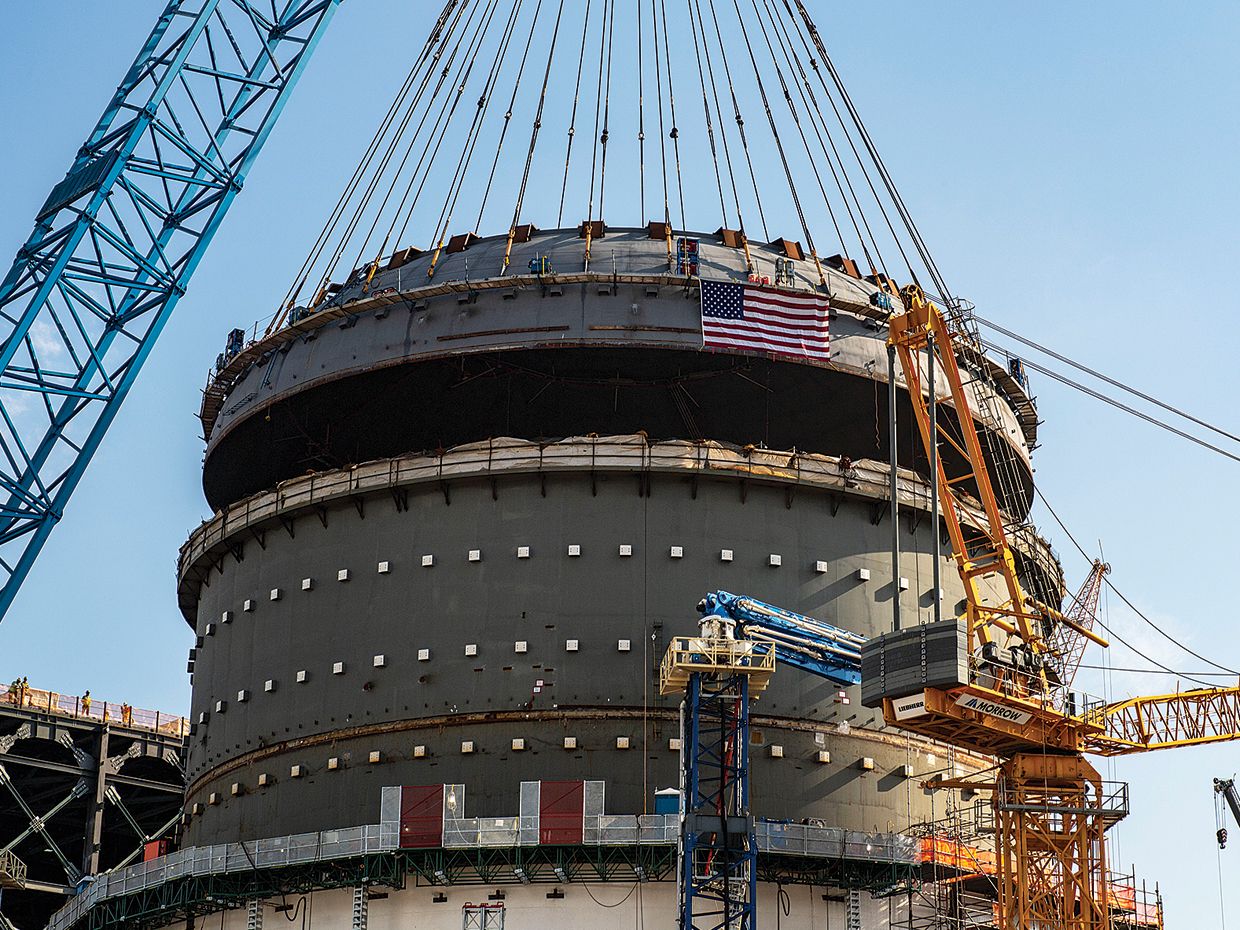Slow, Steady Progress for Two U.S. Nuclear Power Projects
 Photo: Georgia Power Co. Heads Up: A crane lowers a heavy structure called a top head onto the Vogtle Unit 4 containment vessel in Georgia.
Photo: Georgia Power Co. Heads Up: A crane lowers a heavy structure called a top head onto the Vogtle Unit 4 containment vessel in Georgia. There are 53 nuclear reactors currently under construction around the world. Only two are in the United States, once the world's leader in nuclear energy development. And those two reactors represent expansions of a preexisting two-reactor facility, Plant Vogtle in Waynesboro, Ga.
Separately, a company in Portland, Ore., called NuScale Power is now working with the U.S. Nuclear Regulatory Commission to develop a next-generation reactor built around a smaller-scale, modular design.
These two projects together represent the leading edge of commercial U.S. nuclear-fission reactor development today. The fact that there are only two raises questions about the direction of this once-booming energy sector. Is the United States redirecting its focus onto fusion and leaving fission behind? Or could a fission renaissance be yet to come?
Congress upped the U.S. Department of Energy's nuclear fusion budget from US $564 million to $671 million for fiscal year 2020. And such companies as AGNI Energy in Washington state and Commonwealth Fusion Systems in Massachusetts (alongside Tokamak Energy and General Fusion in the United Kingdom and Canada, respectively) are courting venture capital for their multimillion-dollar visions of fusion's bright future.
Meanwhile, in March, construction workers at the Vogtle fission plant hoisted a 680,000-kilogram steel-and-concrete structure to cap one of the containment vessels for the new AP1000 reactors. As John Kraft, a spokesperson for Georgia Power, explained, The shield building is a unique feature of the AP1000 reactor design for Vogtle 3 and 4, providing an additional layer of safety around the containment vessel and nuclear reactor to protect the structure from any potential impacts."
The AP1000 pressurized-water reactor, designed by Westinghouse, is a 21st-century new" reactor. It's been deployed in just two other places, in China, with two AP1000 reactors at the Sanmen Nuclear Power Station in Zheijang province and two at the Haiyang Nuclear Power Plant in Shandong province. According to the International Atomic Energy Agency (IAEA), the AP1000 reactors at these locations operate at 1,157 megawatts and 1,126 MW, respectively.
In 2005, the Nuclear Regulatory Commission (NRC) certified the AP1000 design, clearing the way for its sale and installation at these three sites more than a decade later. Last year, Dan Brouillette, the U.S. secretary of energy, wrote in a blog post: The U.S. Department of Energy (DOE) is all in on new nuclear energy."
NuScale's modular design-with 12 smaller reactors, each operating at a projected 60 MW-met NRC Phase 4 approval at the end of last year. According to Diane Hughes, vice president of marketing and communications for NuScale, This means that the technical review by the NRC is essentially complete and that the final design approval is expected on schedule by September 2020."
NuScale's first customer, the Utah Associated Municipal Power Systems, plans to install a power plant with NuScale reactors at the Idaho National Laboratory site in Idaho Falls. The plant, Hughes said, is slated for operation by the mid-2020s based on the NRC's approved design."
The idea of harnessing multiple smaller reactors in a single design is not new, dating back as far as the 1940s. At the time, the economics of the smaller, modular design could not compete with bigger, individual reactors, says M.V. Ramana, a nuclear physicist and professor at the University of British Columbia's School of Public Policy and Global Affairs.
Nuclear power is unlike almost any other energy technology, in that it's the one tech where the costs have gone up, not down, with experience," he said. The way to think about it is that the more experience we have with nuclear power, the more we learn about potential vulnerabilities that can lead to catastrophic accidents."
However, Hughes of NuScale counters that, unlike the 54 competing small modular reactor designs that the IAEA has records of, NuScale is the first ever small modular reactor technology to undergo...NRC design certification review."
And in 2018, an interdisciplinary MIT report on nuclear energy found that NuScale's reactor is quite innovative in its design. It has virtually eliminated the need for active systems to accomplish safety functions, relying instead on a combination of passive systems and the inherent features of its geometry and materials."
Of course, while the number of catastrophic nuclear accidents (such as Three Mile Island, Chernobyl, and Fukushima) is small for the amount of energy that nuclear power has generated over the past 70 years, Ramana adds, the cost of each accident is astronomical-sacrificing human lives and uprooting untold many more from disaster zones as well as requiring cleanups that cost hundreds of billions of dollars. One every other decade is not good enough," Ramana said.
This article appears in the June 2020 print issue as Limited Progress for U.S. Nuclear."